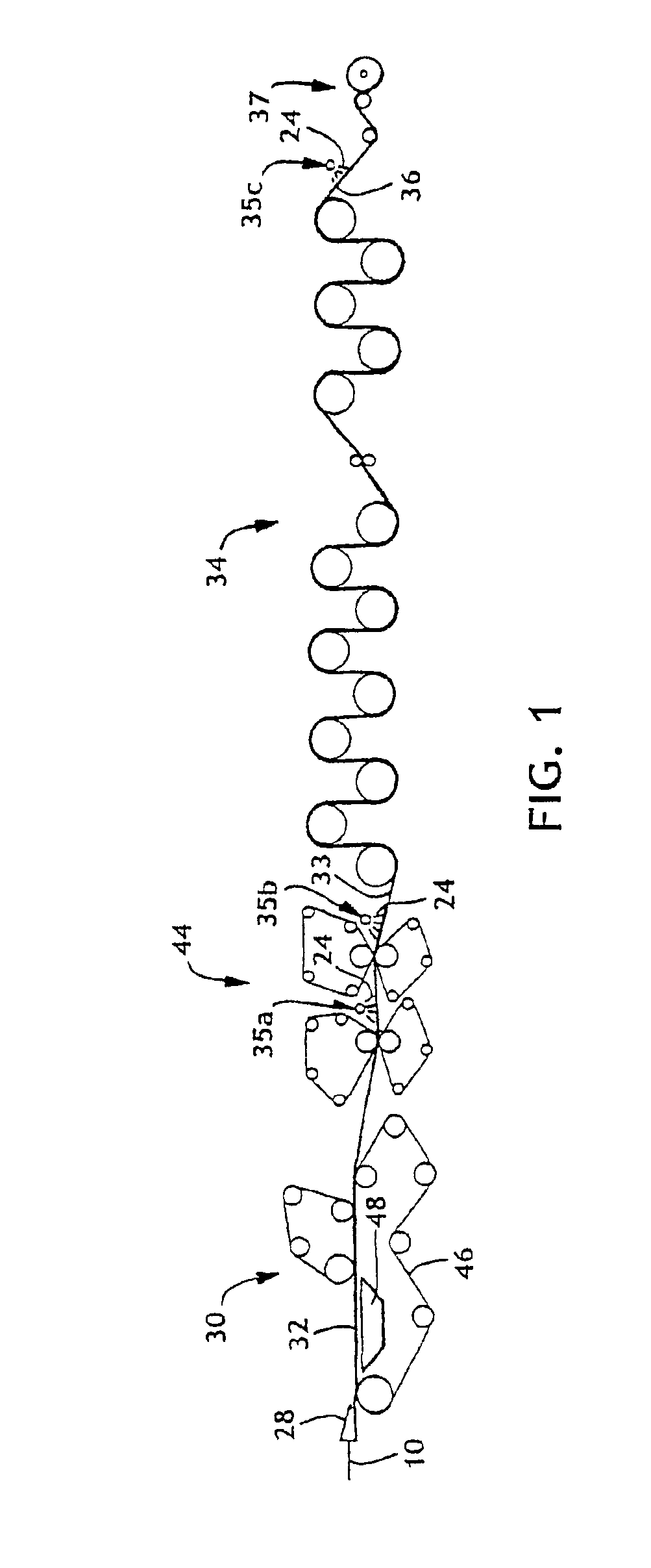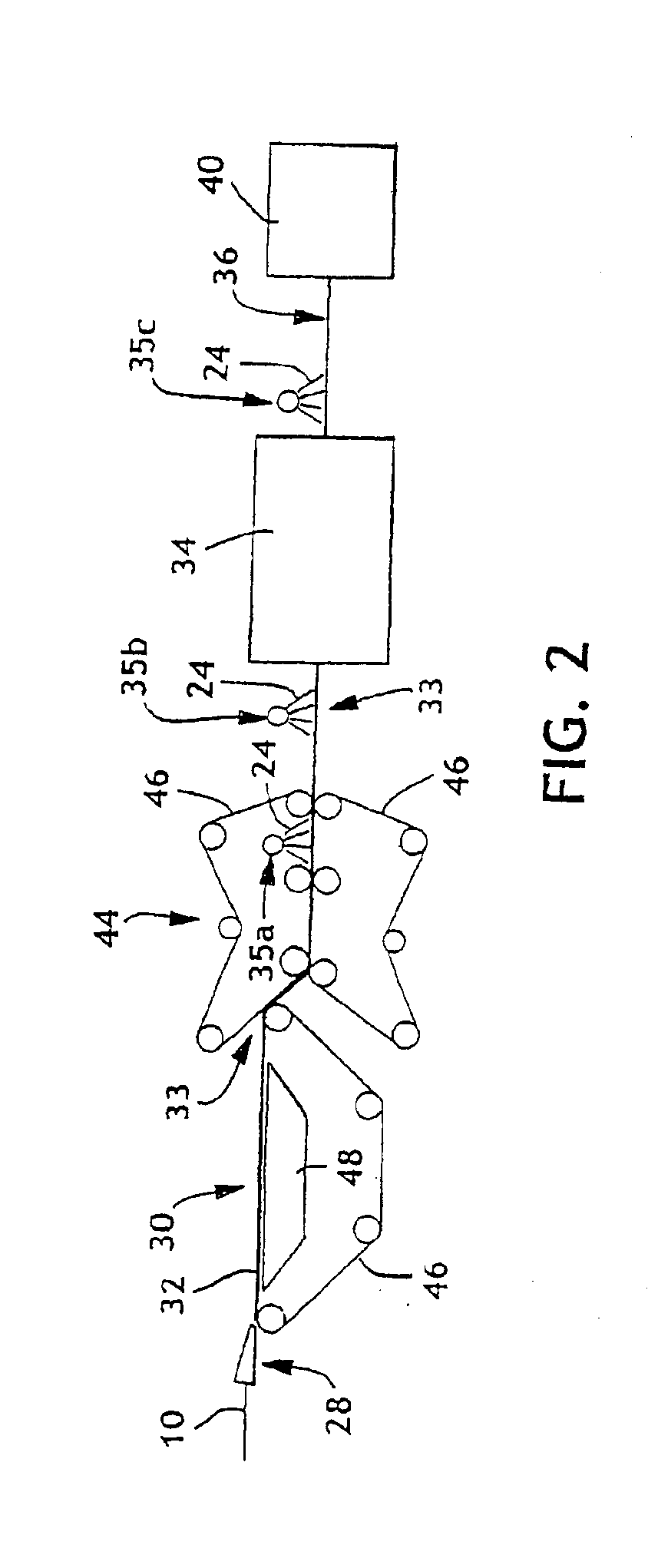Amino-functionalized pulp fibers
a technology pulp fibers, which is applied in the field of tissue making and papermaking, can solve the problems of affecting the amount of additives that may be absorbed or retained in the wet end of the paper machine is generally limited, and the bath tissue should not be able to disintegrate, so as to improve the ability of amino-functional pulp fibers to react. , the effect of increasing the ability
- Summary
- Abstract
- Description
- Claims
- Application Information
AI Technical Summary
Benefits of technology
Problems solved by technology
Method used
Image
Examples
example 1
[0114]Handsheets were prepared and treanted with a wet-strength resin according to standard processes as are generally known in the art. During the pulping process, a eucalyptus fibrous web was treated with 63 kg / MT of Dow Corning amino-functional silicone fluid (Q2-8220) and then repulped to form amino-functionalized eucalyptus pulp. The handsheets were then prepared from both 100% non-functionalized eucalyptus pulp or a 50 / 50 mixture of non-functionalized pulp and amino-functionalized pulp, as shown below in Table 1. The handsheets were treated with 20 pounds per ton of Kymene® 557LX, a polyamine-polyamide-epichlorohydrin resin available from Hercules Inc. of Wilmington, Del., that was added to pulp prior to formation of the handsheets.
[0115]Tensile indices were obtained as reported in Table 1, below.
[0116]
TABLE 1Fiber mixKymene ® 557 LXCode(% non-functionalized / %addedTensile IndexNo.amino-functionalized(pounds / ton)(Nm / g)Control100 013.8011002014.93250 / 5020350 / 5020450 / 5020
example 2
[0117]Amino-functionalized pulp was prepared by repulping a eucalyptus fibrous web which had Jeffamine® D-2000 (an amine terminated polyoxypropylene diol available from the Huntsman Corporation of Houston, Tex.) applied to the web with a brush at a level of 220 lbs / MT.
[0118]Handsheets were prepared according to standard methods as are generally known in the art. Handsheets were formed of either 100% non-functionalized eucalyptus pulp or alternatively of 100% amino-functionalized eucalyptus pulp.
[0119]Examples 2 and 4, as shown below in Table 2, were treated with Kymene® 557LX (a polyamine-amide epichlorohydrin resin available from Hercules Inc. of Wilmington, Del.) which was added to the pulp prior to formation of the handsheets as a percentage based on the weight of the fibers.
[0120]Four handsheet preparations were examined for strength properties. The results are summarized in Table 2, below.
[0121]
TABLE 2Kymene ®Dry Tensile IndexFiber typeadd-on rate(Nm / g)Eucalyptus0%13Eucalyptus1...
example 3
[0123]Amino-functionalized pulp was prepared by repulping a eucalyptus fibrous web which had Jeffamine® T-3000 (a propylene oxide-based triamine available from the Huntsman Corporation of Houston, Tex.) applied to the web with a brush at a level of 30 lbs / MT.
[0124]The amino-functionalized fibrous web was repulped and the amino-functionalized pulp made into handsheets. One sample had no strength agent added to the handsheet formed of the amino-functionalized pulp and another included Kymene® added to the amino-functionalized pulp prior to handsheet formation at a 1% add on rate. The dry tensile index of the handsheet which included Kymene® was 15.15 Nm / g, a jump of 63% from the tensile index of 9.31 Nm / g obtained for the handsheet prepared from the amino-functionalized pulp alone, with no strength agent added to the pulp prior to formation of the handsheet.
PUM
| Property | Measurement | Unit |
|---|---|---|
| solubility | aaaaa | aaaaa |
| total volume | aaaaa | aaaaa |
| depth | aaaaa | aaaaa |
Abstract
Description
Claims
Application Information
 Login to View More
Login to View More - R&D
- Intellectual Property
- Life Sciences
- Materials
- Tech Scout
- Unparalleled Data Quality
- Higher Quality Content
- 60% Fewer Hallucinations
Browse by: Latest US Patents, China's latest patents, Technical Efficacy Thesaurus, Application Domain, Technology Topic, Popular Technical Reports.
© 2025 PatSnap. All rights reserved.Legal|Privacy policy|Modern Slavery Act Transparency Statement|Sitemap|About US| Contact US: help@patsnap.com



